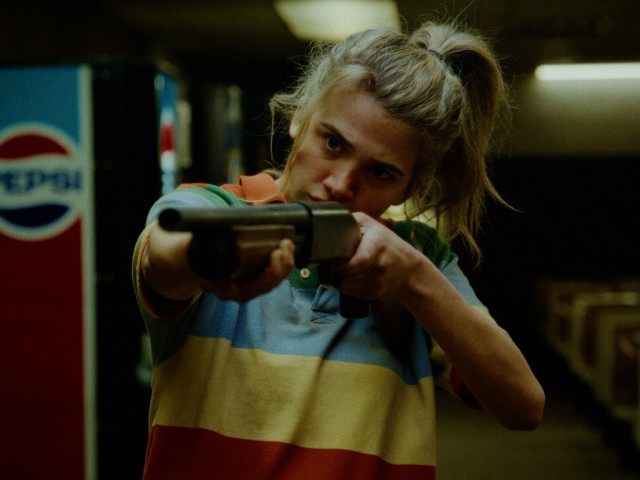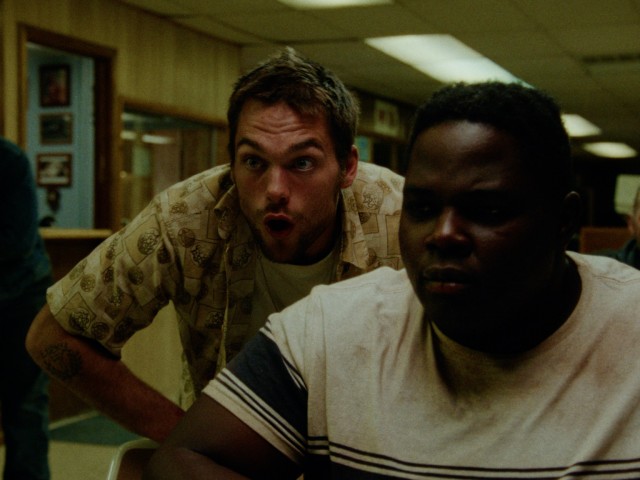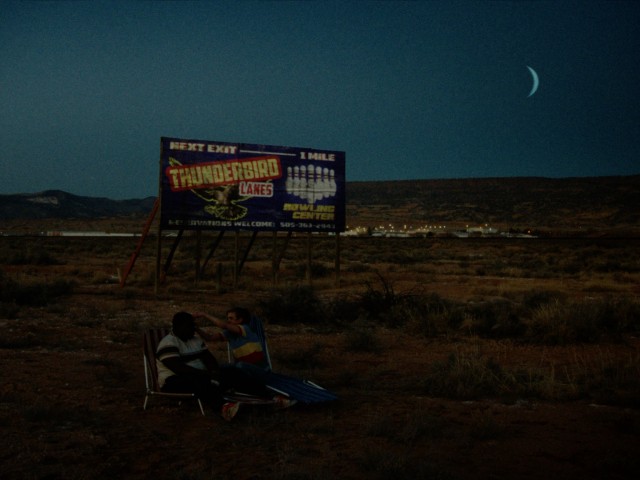It makes both perfect sense and no sense at all. A small German crew, led by a student filmmaker from the Filmakademie, drop into rural New Mexico to shoot a short film. They stay a month, make relationships that will last a lifetime, and wind up with a film that invokes a lost American storytelling mode—the tall tale.
But what do these kids from the heart of Europe know about our towns, our diners, or our deserts that make them think they can tell this sort of story? What do they know of the spirit of The West or the way it has evaporated in the bland uniformity of contemporary society? On the other hand, who else but outsiders still possess the requisite Americanophilia for this sort of myth-making out on the frontier? While not a perfect film, The Boy Who Couldn’t Feel Pain is an ambitious and big-hearted story that admirably straddles the tricky divide between realism and fantasy. It aims for big emotional swells, and largely earns them, telling a nostalgia-tinted tale that speaks to the larger-than-life sensibility that is core to America’s self-conception.

Delilah Napier as the tough-talking teen, Annie.
The film, true to form as a tall tale, starts with a narrator. 16-year-old Annie is new to town and though she comes to play a leading role in the story, first she introduces us to Chester, our titular boy. “He was not the prettiest, nor the smartest guy in town,” she intones gravely, “but he sure as hell was the toughest. For when he was a young boy, he saw something so deeply disturbing, so gut-wrenching, that he stopped feeling anything.”
Impervious to pain from his odd superpower, Chester finds himself employed as a backyard brawler for Nelson, the local gang leader of a shabby crew known as The Sharks. Chester might have kept on that way too, numb physically, but also emotionally, allowing himself to be used by Nelson simply due to the absence of anything better to do until Annie crosses his path. Annie’s dad buys the abandoned bowling alley which The Sharks had been using as their hangout and Chester is ordered to act as muscle in getting it back. However, Annie (albeit in a gruff, folksy way) charms and is charmed in return by her potential assailant. The pair strike up a friendship and, for the first time since that fateful day as a boy, something in Chester begins to change.

Dylan Sprayberry as Nelson and Catfish Jean as Chester
The Boy Who Couldn’t Feel Pain is an effort that would scream “ambitious” coming from any filmmaker. That its writer/director, Eugen Merher, was a student at the time of production only adds to that feeling. Much of its pleasure stems from its worldbuilding, which envisions the town of Grants, New Mexico as a gorgeous, but dilapidated dustbowl with everything a different shade of brown. Mortimer Hochberg’s cinematography is a standout element as he manipulates the soft light of the area for a film-inspired look. Why Grants though? The bowling alley was key to the conception of the film, so Merher and team scoured Google Maps for images of 90’s style American bowling alleys until they uncovered Thunderbird Lanes. A simple phone call to its owner Sandy secured the location, though Merher suspects that, at the time, she didn’t really believe that a group of German kids would come half around the world to shoot in her bowling alley.
“Ever since I was a teenager I’ve been fascinated with the desolateness of some remote American towns,” Merher informed us over email, “I feel it’s places like this where the most interesting and absurd things can happen, but nobody ever hears about them because nobody ever stays there for more than one night.” Obsessed with America since his youth and inspired by directors like the Coen Brothers, Merher began the journey of what would become The Boy Who Couldn’t Feel Pain by brainstorming characters with his producer, Philip Chrobot. The pair arrived on the gap-toothed Annie, a precocious and tough-talking teen. Originally conceived as a brand short, the project began to expand as the idea arrived of a strange character entering Annie’s world who would “get into mindless fights and be in a sort of trance-like state, incapable of feeling pain.”
The order of inspiration is somewhat telling and betrays the main weakness of the short which is its depiction of Chester. Over its 20min the film has difficulty conceptualizing his “superpower” outside of the street fights and after a rousing opening, there is some tonal slippage in the film’s comparably soft middle. The magical realist elements get lost and the film becomes a more conventional drama, while attempts to reassert the tall tale aspects land heavily (”some say he ran for a whole three days and three nights”…). Also, Chester’s defining characteristic, stemming from his unprocessed trauma, leads the character to a “trance-like” state that is closely related to a lack of agency. Annie’s friendship and advocacy get him moving again, but in doing so she fulfills a role that is uncomfortably reminiscent of the trope of “white savior”.
Yet, the climactic decision of the film is Chester’s, and whatever triumph or failure that comes from it belongs to him too as he is ultimately the character with the most classic “arc” in the narrative. The filmmaking as a whole shows affection for all its characters (even its antagonist, Nelson) as it’s clear that Merher is interested in telling a big and timeless sort of story; one of underdogs and bullies, of getting knocked down, only to get back up. It is one of exceptionalism, but also vulnerability, and, frankly, it is a lot of fun! It is very hard to take these big swings towards the fantastic and full-throated sincerity without landing in cringe territory, and Merher’s expert modulation of these emotional beats, paired with the worldbuilding we highlighted earlier, is a rare combo that I expect will make him a highly in-demand filmmaker in the coming years.
In the wake of his celebrated student work, Merher has landed on several impressive commercial rosters. While advertising will surely occupy some of his attention, going forward his main ambition is feature storytelling and he is currently looking to adapt one of his previous films, a London vampire short called Dark Red, into a feature.

 Jason Sondhi
Jason Sondhi
